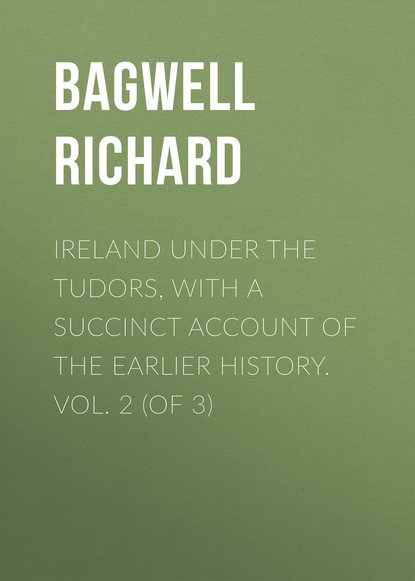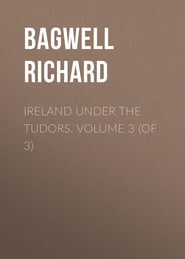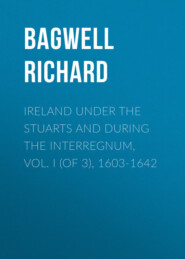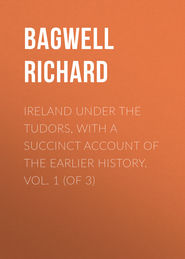По всем вопросам обращайтесь на: info@litportal.ru
(©) 2003-2024.
✖
Ireland under the Tudors, with a Succinct Account of the Earlier History. Vol. 2 (of 3)
Настройки чтения
Размер шрифта
Высота строк
Поля
Robert Daly
Irish Protestantism naturally Puritanical
Alexander Craik, a Scot, was appointed by patent in 1560, and was allowed to hold the Deanery of St. Patrick’s also. He is accused of impairing his bishopric by alienating the lands, but he was in the direst poverty, and he evidently had a conscience, so perhaps this may be calumny. ‘Neither,’ he wrote to Leicester, ‘I can preach to the people nor the people understand me.’ Loftus was his chaplain and only ally, and he begged to be released. His deanery of St. Patrick’s was valueless to him, for William Basnet claimed to hold it by a lease of Henry VIII. Nevertheless the Crown pressed him for first-fruits, and he had not wherewithal to pay the bare expenses of his removal to Ireland. As a preacher he was overworked, and when he imported an assistant from Hampshire, the Bishop of Winchester cited the latter for non-residence. Both for the sake of his health and his pocket he begged leave to visit England, but apparently the request was refused, and in 1563 he was actually in prison for 632l. due on account of first-fruits which he had not the means to pay. He died in the following year, and the see was given, unsolicited, to Robert Daly, a Prebendary of St. Patrick’s, whose power of preaching in the Irish language recommended him to the Queen. The net value of his bishopric not being more than 50l. a year, Daly was allowed to retain his prebend as well as the vicarage of Swords. He was a sincere and energetic Calvinist, and in 1565 he wrote to Cecil lamenting the measures taken against the Puritans. ‘The poor Protestants,’ he said, ‘being amazed at the talk doth oft resort towards me to learn what the matter means: whom I do comfort with the most fruitful texts of Scripture that I can find, willing them to put their trust in God, who promised that the faith should not decay in His elect, and never to leave His flock comfortless.’ We have here the germ of many future troubles. Irish Protestantism, being the religion of a minority in a Roman Catholic country, naturally took a Calvinistic hue, and the attempt to make it conform to the views of Parker, Whitgift, Laud, and others destroyed any chance which the State Church might have had. Daly begged for such encouragement as would enable him not only to comfort his friends, but to ‘suppress the stout brags of the sturdy and proud Papists.’ He remained Bishop of Kildare for eighteen years, during which he was turned out of house and home three times by the rebels. The last outrage was in 1582, and is supposed to have caused his death.[370 - Brady; Cotton; Ware; Alexander Craik to Lord R. Dudley, April 30, 1561; to Cecil, Jan. 2 and 10, Feb. 10 and 18, April 23, 1562, and Aug. 5, 1563; Robert Daly to Cecil, July 2, 1565.]
Ossory
The see of Ossory, which it was in Ormonde’s power to protect, would naturally have been one in which the State religion might have had a fair chance. John Thonery was in possession at Mary’s death, and Bale was also alive. The Kilkenny historian says the Protestant Bishops derive their succession through Thonery, but there is a difficulty about this, for an official document written in 1565 declares the see to have been long vacant, and another paper written while Bale was still alive also treats it as vacant. Now Bale died in 1563, and Thonery certainly not before 1565. Thonery was employed by the Government in 1559, and there is some evidence that he was considered still Bishop in 1567. But the Queen appointed Christopher Gafney towards the end of 1565. From these rather contradictory data it may perhaps be inferred that Thonery never conformed, but that he was not formally deprived. Probably he left the country, for he was certainly considered the true Bishop at Rome. The consistorial act nominating Thomas Strong in 1582 declares the see to have been many years vacant, since the death of Thonery, the last Bishop. Strong made his way to Ireland in 1584, but found his position untenable, and died in Spain in 1602, having long acted as suffragan to the Bishop of Compostella.[371 - Brady; Cotton; Instructions to Sir H. Sidney, July 4, 1565; Shirley’s Original Letters, p. 101; Graves’s History of St. Canice’s Cathedral, p. 295.]
Leighlin
Thomas O’Fihily, or Field, was Bishop of Leighlin at Elizabeth’s accession, and undoubtedly conformed, fully abjuring the Pope’s authority. He died in 1566, and was buried in his own cathedral. Here, therefore, is an undoubted link between the Marian and Elizabethan Churches. Alexander Devereux, who was made Bishop of Ferns in 1539, and consecrated by Browne, managed to hold his see through the remainder of Henry’s reign, and through the reigns of Edward, Mary, and Elizabeth, till his death in 1566. He is acknowledged both in the Papal and Protestant successions, but was a man of indifferent character and no credit to either Church.[372 - Brady; Cotton; Memoranda of private suits, July 16, 1559.]
Cashel
Rival Archbishops
Roland Baron was made Archbishop of Cashel by Mary, and held the see till his death in 1561. But this case does not affect the succession, for Baron, on account of some informality perhaps, was never acknowledged at Rome. In 1567 rival archbishops were appointed. The Queen’s nominee was James MacCaghwell, an Irishman, whose learning and virtue had recommended him to Jewel. Jewel handed him on to Loftus, who advised that he should have Cashel, ‘the living being very small and not meet for any but of that country birth.’ The Primate evidently thought all fat things should be reserved for Englishmen like himself. The still poorer diocese of Emly was added during MacCaghwell’s episcopate; but he had little enjoyment of either see. Maurice Reagh FitzGibbon was appointed by the Pope, and in some way violently dispossessed the Queen’s man. Hooker says he wounded him with a knife, but if that happened it was more probably the act of some kerne. MacCaghwell seems, however, to have been closely imprisoned, so that his whereabouts became doubtful. Primate Lancaster said that FitzGibbon had carried his rival into Spain. For a time at least FitzGibbon got possession of the cathedral, and is said to have forced his rival to remain in the choir while he celebrated mass. The rough treatment to which MacCaghwell was subjected may have shortened his life. At all events he died in 1570, and Meiler Magrath was appointed in his place. FitzGibbon’s triumph was shortlived, for he did not venture to visit his diocese. From 1569 to 1578, he seems to have remained on the Continent defying Walsingham’s schemes to entrap him, and it is doubtful if he ever returned to Ireland.[373 - Brady collects most that is known about this curious rivalry; see also Spicilegium Ossoriense, i. p. 83, and Hooker under the year 1567. For MacCaghwell, see Loftus to Cecil, July 3 and Nov. 7, 1566, and Shirley’s Original Letters, p. 132.]
Waterford and Lismore
The sees of Waterford and Lismore were united in the fourteenth century. Patrick Walsh, an Oxford graduate, who had been Dean of Waterford since 1547, was appointed in 1551 by congé d’élire, followed by capitular election, and remained in possession during the reign of Mary. The probability is that he was at first a waverer whose English education induced him to conform to Henry VIII.’s arrangements, and that he gradually reverted to Rome. When Sussex entered Waterford in 1558 the Bishop received him in his robes, but the Protestant ritual had not yet been re-established. Walsh resigned his deanery in 1566 in favour of Peter White, who was a very good man but certainly no Protestant. The Bishop retained his place in both successions, but when he died in 1578, Waterford, in the opinion of English Protestants, was thoroughly given up to ‘superstition and idolatry,’ to ‘Rome runners and friars;’ and so it remained during the whole of Elizabeth’s reign. Walsh’s Protestant successor, Marmaduke Middleton, only sat some three years, and was practically expelled by the hostility of his flock. He was translated to St. David’s, and the diocese then fell for several years into the all-devouring maw of Meiler Magrath. The Popes made no appointment till 1629.[374 - Brady; Cotton; Captain Gilbert Yorke to Walsingham, Dec. 5, 1579; and several letters of Bishop Middleton, with recriminating answers on the part of the townsmen.]
Cork and Cloyne. Ross
Cork and Cloyne were united in the fifteenth century, and Dominic Tirrey was appointed in 1536. He held possession of the see for twenty years, but was never acknowledged at Rome, and there is a double succession from the year 1540. The remote see of Ross does not appear to have been filled either by Henry VIII., Edward VI., or Mary. Papal appointments were made in 1519, 1526, 1554, 1559, and 1561. In 1582 William Lyon was appointed by patent, and soon afterwards received Cork and Cloyne also. The three sees have since been united in the Protestant succession, but the Papal see of Ross has continued separate, though no appointment appears to have been made between 1582 and 1647.[375 - Brady and Cotton.]
Limerick
William Casey, who was undoubtedly a Protestant, was appointed Bishop of Limerick in 1551. He was deprived by Mary, but restored by Elizabeth in 1571. Between 1556 and 1571 the see was held by Hugh Lacy, who was not a Protestant, though he seems to have been something of a trimmer. Yet he made no attempt at concealment when Sidney visited his cathedral in 1568. Lacy cannot be held to have conformed, for when the temporalities were restored to Casey he continued to act as Papal Bishop till his death in 1580, not long before which he suffered a short detention in his own house. There is a regular double succession from 1571.[376 - Brady and Cotton.]
Ardfert and Aghadoe. Killaloe. Kilfenora
James Fitzmaurice, Cistercian Abbot of Odorney, was made Bishop of Ardfert and Aghadoe by the Pope in 1536. Queen Elizabeth made no appointment till 1588, some years after Fitzmaurice’s death. Her nominee was unable to hold his ground in Kerry, nor was the Papal Bishop permanently resident. The facts about Killaloe are not very clear. From a comparison of dates it would appear that Bishop James O’Corren, who took the oath of supremacy in 1539, was deprived or suspended at Rome, that he afterwards resigned, that the see was for a time governed by vicars, and that Terence O’Brien was made Bishop by the Pope in 1554. Bishop O’Brien died in 1569, and the Government seems not to have interfered with him. The temporalities were soon afterwards handed over to Maurice MacBrien Arra, who, on account of his youth, was not consecrated till 1576. In the meantime the Pope had appointed Malachy O’Molony. MacBrien was educated at Cambridge, and doubtless conformed, as he remained Bishop till 1612. Being chief as well as pastor, he had a better chance of success than most of Elizabeth’s men, but he had trouble with his Papal rivals, O’Molony and O’Mulrian, the latter of whom was appointed in 1576. O’Mulrian, who was a sharp thorn in the side of Government during the Desmond rebellion, died in Portugal in 1616, having been an exile for many years. John O’Nialain, appointed by Papal provision, was Bishop of Kilfenora from 1541 till his death in 1572. The Popes made no fresh appointment until 1647, nor is it certain that the Queen made any at all.[377 - Brady; Cotton. Ware mentions a Bishop-elect of Kilfenora in 1585, but the appointment seems to have come to nothing. No doubt the see was extremely poor.]
Tuam. Kilmacduagh. Clonfert. Achonry. Elphin. Ardagh
Christopher Bodkin was Archbishop of Tuam at Elizabeth’s accession. He was on fairly good terms with the Government, but there seems no reason to suppose that he turned Protestant in any real sense. As he sat uninterruptedly from 1536 to 1572, we may not uncharitably suppose him to have had rather an elastic conscience. After his death the two successions are separate. Redmund O’Gallagher was Bishop of Killala from 1549 to 1569, from which latter date the successions are separate. O’Gallagher was not at any time a Protestant. Kilmacduagh was held by Bodkin with Tuam, after which Stephen Kirwan was appointed by the Queen and Dermot O’Diera by the Pope. Elizabeth never made any appointment to Achonry, which may be considered purely Papal during her reign. The see of Elphin was held along with Clonfert till 1580, when Thomas Chester, an Englishman, was appointed by the Queen. The Papal succession is altogether separate. The local influence of Roland de Burgo enabled him to keep possession of Clonfert from 1534 till his death in 1580. He conformed so far as to take the oath of allegiance in 1561, but he was not a Protestant. The successions separate after his death. On the whole it may be said that Queen Elizabeth scarcely interfered in Church matters in Connaught; at least towards the end of her reign.[378 - Brady and Cotton.]
Spiritual peers, 1560 and 1585. Papal and Protestant succession
Lists have been preserved of three archbishops and seventeen bishops ‘in a certain Parliament’ held in 1560, and of four archbishops and twenty-two bishops ‘answerable to the Parliament in Ireland, and summoned unto the Parliament holden in 1585.’ It has been assumed by some writers that all the prelates mentioned in the first list actually attended Parliament; whereas it is much more probable that many were only summoned, as is expressly stated in the second list. The mere fact of certain sees being named in any such list is no proof that the incumbents conformed to Elizabeth’s arrangements. Some of the bishops, even if present, may have voted against the Acts of Supremacy and Uniformity. The position of the twenty dioceses mentioned in the list may be briefly summarised thus: – One archbishop, Curwen of Dublin, conformed. Christopher Bodkin of Tuam may, from his character, have conformed insincerely, but this is not proved. Baron of Cashel had never been confirmed by the Pope, so that his case does not count, though there is no proof of his having conformed. Walsh of Meath and Leverous of Kildare were deprived. O’Fihily of Leighlin conformed. In the remaining cases, the evidence is not very distinct as to formal conformity or the reverse, but many can be proved to have been Roman Catholics, and none can be proved to have been Protestants. No doubt some bishops took the oath of allegiance at the beginning of Elizabeth’s reign who could not have done so after her excommunication. Some had already acknowledged the supremacy of Henry VIII., in which they were countenanced by Gardiner himself. The fact that no Christian name is assigned to the Bishops of Emly, Ross, Killaloe, Achonry, Killala, Ardfert, and Ardagh, tends to prove that many of the sees given in the list were not really represented. The Dublin officials knew something about the Leinster, and a few of the Munster bishops; of the more distant sees they knew no more than the bare names.[379 - The above is from a close comparison of the data in Cotton and Brady, and in the Parliamentary Lists in Tracts Relating to Ireland, vol. ii. The twenty prelates mentioned in the list of 1560 are thus disposed of: —]
The state of the Irish Church during the early years of Elizabeth was as lamentable as it is possible to conceive. A report made in 1566 by the Irish Council to the Privy Council says that Curwen of Dublin, Loftus of Armagh, and Brady of Meath did their best, both in preaching and in looking after their clergy. ‘Howbeit,’ they continue, ‘the work goeth slowly forward within their said three dioceses by reason of the former errors and superstitions inveterated and leavened in the people’s hearts; and in want of livings sufficient for fit entertainment of well chosen and learned curates amongst them, for that those livings of cure being most part appropriated benefices in the Queen’s Majesty’s possession, are letten by leases unto farmers with allowance or reservation of very small stipends or entertainments for the vicars or curates, besides the decay of the chancels, and also of the churches universally in ruin, and some wholly down. And out of their said dioceses, the remote parts of Munster, Connaught, and other the Irish countries and borders thereof (saving the commissioners for the ecclesiastical causes have travelled with some of the bishops and others, their ministers residing in the civil and nearer parts), order cannot yet so well be taken with the residue until the countries be first brought into more civil and dutiful obedience. I, the Deputy (Sidney), have given charge to the said bishops to make diligent search, and to certify me in the next term, of every the said decayed chancels and churches in their dioceses, &c… The livings of the prebendaries of St. Patrick’s are most part in benefices with cure, and they for the most part aged men who, with the rest of the ministers of that College, according the rules of the same, give their due attendance on that collegiate church, daily doing divine service, and devotion with due reverence and harmony convenient, and some of them do preach also. Nevertheless, they have been treated with by us the Archbishops of Dublin and Armagh, and Bishop of Meath, and are found conformable to depart with such portion of their livings as shall be thought fit by her Highness for the setting forth and maintenance of learning and teaching for this realm… We know not as yet of any alienations or wastes suffered to be made by the clergy, nor of any appropriations of benefices by them put in use, nor that the clergy of this realm are greatly inclined to offend in that part, except the alienations or wastes done by the Bishop of Ferns, who to the use of his sons hath put away the most part of the living of his bishopric.’[380 - Lord Deputy Sidney and Council to the Privy Council, April 15, 1566.]
The Jesuit, David Wolfe
Meanwhile the Popes were busily countermining. The Jesuit, David Wolfe, a Limerick man who had spent several years at Rome, was selected by Pius IV. for the Irish service. The Pope wished to make Wolfe a bishop, and to invest him with all the pomp proper to a nuncio. Lainez, who had recommended Wolfe, opposed this, lest the humility of the society should be offended, and lest the Papal insignia should make the envoy’s work harder. The General’s advice was taken, and Wolfe started for Ireland with the full power of a nuncio, but without noise or show. After having been arrested in France as a Lutheran, he reached Cork in January 1561. All his luggage had been lost at sea, and he found it difficult to obtain bare subsistence, being unwilling either to incur obligations or to beg. He managed, however, to maintain himself for several years in Connaught and Western Munster. In 1563 he issued a commission to Thady Newman, a Dublin priest, giving him power to grant absolution ‘to all and singular persons, both lay and ecclesiastical, and of either sex, in all cases even if grave and enormous, and specially from the crimes of heresy and schism, and to reconcile them to mother church on doing penance, and making a public or private abjuration.’ Wolfe, who wrote from Limerick, says the danger of the journey would not suffer him to visit Leinster. He reported among other things that Tuam Cathedral had been used as a fortress for 300 years, during which time mass had not been said there; and that Archbishop Bodkin had restored it to its proper use. There were only twenty or thirty houses in Tuam. Ardagh Cathedral was also used as a fort and in lay hands. About 1566 Wolfe fell into the power of the Government, and was confined in Dublin Castle. A bishop, probably Leverous, visited him there, and was driven away by the stench. In 1572 or 1573 Wolfe made his escape, perhaps by means of money sent from Spain, to which country he fled. The Protestant Bishop of Cork says ‘he foreswore himself,’ whence it seems probable that the severity of his confinement had been relaxed. Wolfe returned to Ireland with James Fitzmaurice. Perhaps he did as much as any one man to preserve the Papal power in Ireland.[381 - Hogan’s Hibernia Ignatiana, pp. 15 to 20. Wolfe’s commission to Thady Newman is in the R.O., Dec. 7, 1563; Interrogatories for Kian O’Gara and others, May 1572; Matthew Seaine, Bishop of Cork, to Lord Deputy Fitzwilliam, in the latter’s letter to Burghley, Oct. 13, 1573.]
notes
1
Sir John Alen to Cecil, Dec. 16, 1558; Staples to same, Dec. 16; T. Alen to same, December 18. Harris’s Dublin, chap. ii.
2
Ancient Laws and Institutes of Ireland, vol. iii.; Preface to Book of Aicill, p. cxlviii.; Shane O’Neill to Queen Elizabeth, Feb. 8, 1561; Campion’s History; Four Masters, 1558. Maine’s Early History of Institutions, chap. ii.
3
See the arguments in Carew, 1560, vol. i. p. 304.
4
There is an account of the interview in Hooker.
5
Instructions to Sussex, 1559, in Carew, pp. 279 and 284.
6
Mant from Loftus MS.; Ware’s Annals.
7
Memorial of answers by the Queen, July 16, 1559, and Instructions to Sussex, July 17, both in Carew; note of the Earl of Clanricarde’s wives and concubines now alive, Feb. 1559 (No. 18).
8
The list of this Parliament is in Tracts relating to Ireland, vol. ii., Appendix 2; Printed Statutes, 2 Elizabeth; Collier, vol. vi. p. 296 (ed. 1846); Ware’s Annals; Leland, book iv. chap. i.
9
Fitzwilliam to Sussex, March 8 and 15, 1560.
10
Fitzwilliam to Cecil, April 11, 1560; Advertisements out of Ireland, May (No. 15), and many other papers about this time.
11
Memorial by the Earl of Sussex for the Queen, May 1560 (No. 21).
12
See the two sets of Instructions in Carew, vol. i. May 1560, Nos. 223, 225.








